The two-state solution is more popular with Palestinians, less with Israeli Jews
Palestinian Center for Policy and Survey Research,
1 August 2017
Support for the two state solution rises among Palestinians but declines among Israeli Jews, while support for a comprehensive peace agreement remains unchanged among Palestinians but drops among Israeli Jews. But a package of incentives shows that attitudes are flexible on both sides, and motivates significant shift in favor of the peace package leading to majority support on both sides. Unilateral recognition of each side’s national claims is one of the most effective incentives for both. However, perceived lack of feasibility remains closely linked to rejection of the two-state solution and its package of implementation

PressRelease
Table of findings
These are the results of Palestinian-Israeli Pulse: A Joint Poll conducted by the Tami Steinmetz Center for Peace Research (TSC), Tel Aviv University and the Palestinian Center for Policy and Survey Research (PSR) in Ramallah, with funding from the European Union (EU) and the Netherlands Representative Office in Ramallah.
MAIN HIGHLIGHTS
- A majority of both Israelis (53%) and Palestinians (52%) support the two-state solution. Palestinian support has risen since December 2016, when 44% supported the solution in principle; among Jews support stood at 50% in December declining to 47% in the current poll.
- Still, fewer people support three possible alternatives to a two-state solution: one state with equal rights, one state without rights, and expulsion or “transfer.”
- Only 43% of Palestinians (hardly any change from December, when 42% supported it) and 32% of Israeli Jews (a nine-point decline from the previous survey) support a permanent peace agreement package, along with 83% of Israeli Arabs – typical of the high level support from Israeli Arabs in previous surveys. In total, 41% of Israelis support the detailed agreement. The peace package comprises: a de-militarized Palestinian state, an Israeli withdrawal to the Green Line with equal territorial exchange, a family unification in Israel of 100,000 Palestinian refugees, West Jerusalem as the capital of Israel and East Jerusalem as the capital of Palestine, the Jewish Quarter and the Western Wall under Israeli sovereignty and the Muslim and Christian quarters and the al Haram al Sharif/Temple Mount under Palestinian sovereignty, and the end of the conflict and claims. Fifty-three percent of Israelis and 54% of Palestinians are opposed to the two-state comprehensive package.
- The skepticism about the package appears closely related to serious doubts about feasibility. Palestinians and Israelis are both divided almost equally about whether a two state solution is still possible, or whether settlements have expanded too much to make it viable. Among all Israelis, nearly half believes the solution is still viable (49%), while 44% think settlements have spread too much for it to be viable. Among Palestinians, 52% say the two state solution is no longer viable, while 44% think it is. But fully 71% and 79% of Palestinians and Israeli Jews, respectively, do not expect a Palestinian state to be established in the next five years.
- Despite the majority rejection of the two state implementation package, their opposition can be shifted significantly based on added policy incentives. For example, 43% of Jews who are opposed would change their minds if the Palestinians recognize Israel as a Jewish state, including the historic and religious ties to the land – bringing total support to a 58% majority. Almost the same portion of Palestinians, 42%, would change their minds to support the agreement if Israel recognized the Arab and Muslim character of the Palestinian state. When the Palestinians who change their minds for this item are added to original supporters, 66% – nearly two thirds – support the agreement.
- When both sides are offered four similar options for what should happen next on the conflict, both Palestinians and Israelis choose “reach a peace agreement” by a clear plurality, in almost identical numbers: 44% and 45%, respectively. However, just over one-fifth of Palestinians called for an armed struggle against Israel, and 12% of Israelis sought a definitive war with the Palestinians.
The Palestinian sample size was 1,200 adults interviewed face-to-face in the West Bank, East Jerusalem and Gaza Strip in 120 randomly selected locations between 29 June-1 July, 2017. The number of interviewees in the West Bank (including East Jerusalem) is 780 and in the Gaza Strip 420. The margin of error is 3%. The Israeli sample includes 902 adult Israelis interviewed by phone in Hebrew, Arabic or Russian between 11 June – 6 July, 2017. The number of Jews interviewed inside Israel is 650, West Bank settlers 100, and Israeli Arabs 150. The Israeli settler and Israeli Arab samples were deliberately increased in order to allow for detailed analysis of their attitudes. The combined Israeli data file has been reweighted to reflect the exact proportionate size of these two groups in the Israeli society. The data file was further reweighted to reflect current demographic and religious-secular divisions. The margin of error is 3%. The survey and the following summary have been drafted by Dr. Khalil Shikaki, director of PSR, and Dr. Dahlia Scheindlin together with the Tami Steinmetz Center for Peace Research and its director, Dr. Ephraim Lavie.
______________________________________________________________
MAIN FINDINGS
The following sections compare and contrast findings regarding Palestinian and Israeli public opinion in general. However, when important differences, mainly between Israeli Jews and Arabs, or between Israeli Jews living inside the Green Line and settlers living in the West Bank, or between Palestinians living in the West Bank (West Bankers) and Gazans were found, we also provided the respective findings for these sub groups.
(1) Israeli-Palestinian Peace Process
Two-state solution: Today, a slim majority of Palestinians and Israelis support the two state solution stated as a general principle, without details, in almost identical numbers: 52% of Palestinians and 53% of all Israelis. However, in the current survey, fewer than half of Israeli Jews support the principle – 47%. The Jewish respondents are evenly divided between support and opposition, which stands at 46% (another 8% did not give an opinion). The finding for support among Israeli Jews has declined in mild increments from June 2016, when it stood at 53%, to 50% in December. Over this time there was a decline in support among Israeli Arabs as well but the portion still stands at 81%, a large majority in favor – this increases the weighted average for all Israelis to the current 53% majority. Among Palestinians support rose eight points from December 2016, when 44% supported the basic two state solution in principle, to over half at present. Forty-five percent of Palestinians oppose the principle of two states. Significant differences are seen by region: in the West Bank, 48% support the two state solution, while in Gaza, 61% support it.
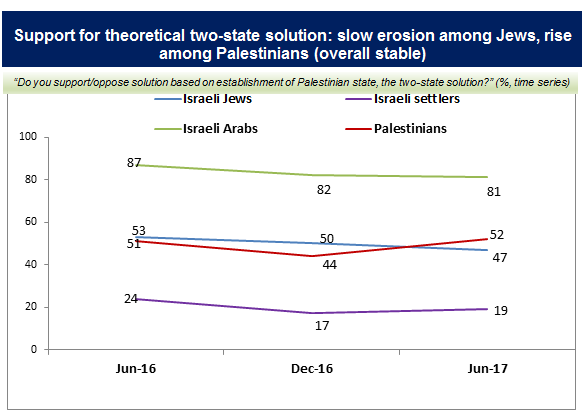
Perceptions of public support. When asked if they believe their own societies support the two state solution, 28% of Jews believe the majority of Israelis support it, unchanged from December, and 53% believe the majority opposes it; thus perceptions of their society are inaccurately weighted towards rejection, rather than the reality of evenly divided opinions. Among Israeli Arabs, 51% think that most Israeli Jews support the principle of a two state solution
On average the Palestinian perceptions of both Palestinian and Israeli attitudes towards the two state solution are as divided as the publics actually are, on both sides. Nearly half of Palestinians, 48%, think the majority of their fellow Palestinians support the two state solution, and 43% think the majority opposes it. Similarly, 42% of Palestinians think the majority of Jewish Israelis support this solution and 45% think they oppose it.
Feasibility. To understand the division of opinion about the two-state solution, it is useful to consider the findings regarding the feasibility and implementation of a two state solution. These findings help to explain why large portions are skeptical. When asked about the chances that an independent Palestinian state will be established in the next five years, among Palestinians, only 5% view the chances as high or very high that such a state will be established in the next five years. Fully 71% of Palestinians say the chances are low or very low.
Among Israeli Jews even a larger majority of 79% think the chances are low or very low, 43% of Israeli Arabs take this view, and the weighted average for all Israelis is 72% who do not believe a state will be established in that time. The remainder, fewer than one-fifth of Israelis and just over one-fifth of Palestinians, say the chances are “medium.”
Further, the view that the two-state solution is no longer even feasible can increasingly be heard in general social and public discourse. We tested this belief directly, asking respondents on both sides whether settlements have expanded too much, making a two-state solution impossible, or whether settlements can still be dismantled or evacuated and therefore the solution is still viable. Among Palestinians, a slight majority of 52% believes the solution is no longer viable – this rate is higher in the West Bank, 56%, compared to 46% of Gaza residents. Once again Israelis are divided, with 49% among both Jews and Arabs who think the solution is still viable, compared to 43% of Jews who think it is not, and 49% of Arabs.
Since settlements are commonly considered the primary obstacle to a future Palestinian state, Israelis were asked additionally the key question of whether they support or oppose evacuating settlements. The question explained in detail that most plans involve dismantling settlements outside the main blocs in the West Bank, requiring anywhere between 30,000-90,000 settlers to move – these are conservative numbers and neutral language. The survey found that a majority of 54% of Israeli Jews opposed the evacuation. Among settlers, 84% opposed it, with high intensity: 68% said they “strongly” opposed, and 16% “somewhat” opposed. Among Jews living inside the Green Line, 52% opposed evacuating settlements outside the bloc. Nearly three-quarters of Israeli Arabs respondents support this (73%).
Separately, all Israeli Jews were asked about cultural and economic boycott of Israel and its impact on the Israeli government policy toward the two-state solution. About one-third of these respondents said that if such boycotts worsen, Israel should change its policy and work towards a two state solution.
Trends favoring peace remain. Despite divisions of opinion over the two state solution and implementation, the public on both sides prefers peace to violence at present. When given four options for what should happen next, nearly half – 45% – of Palestinians said there should be a peace agreement, more than double the portion who chose armed struggle (21%). The findings are similar for Israelis, 45% chose peace, nearly four times as many as those who chose “a definitive war,” against Palestinians, just 12%.
Three competing alternatives to the two-state solution: One state with equal rights, one state without equal rights (apartheid), and expulsion or “transfer”
The joint poll sought to ascertain the breakdown of Palestinians and Israelis regarding various alternatives to the two-state solution. Three alternative options were offered: (1) one state solution with equal rights for Jews and Palestinians (one state), (2) one state solution in which one side or the other is denied equal rights (apartheid), (3) a single state in which the other side is “transferred” or expelled from the entire territory of historic or Mandatory Palestine (expulsion). It should be noted that for options two and three, Israeli Arabs were asked questions identical to those asked of Palestinians, i.e., in which rights of Jews are denied in the second option and expulsion is applied to Jews in the third option.
The findings show a high level of overlap: in other words, a single respondent often supported more than one of the three alternative options. In the following analysis we sought to identify a “core constituency” for each alternative option: i.e., the greatest number of respondents who would support the most desirable response – for the purposes of this analysis, the two-state solution – even if they support other responses. We then quantified the greatest number who supported the second, third and least desirable options.
To explain how this was done – in the first stage of the analysis, respondents who support a two-state solution are removed from the constituencies that support any of the other alternatives. In a second stage, those who support a one-state solution are removed from the constituencies that support either or both of the remaining two alternatives, apartheid and expulsion. In the final stage, we separate the remaining two groups by removing those who support apartheid from the constituency that supports expulsion.
As the two pies below show, the largest constituency is the one that supports the two state solution. Once those respondents are excluded from the sample and the remaining public is assigned one alternative at a time, the public splits almost equally on each side, between the three alternatives without any one emerging as the most preferred. The category called “other” refers to respondents who either rejected all options or responded “do not know.”
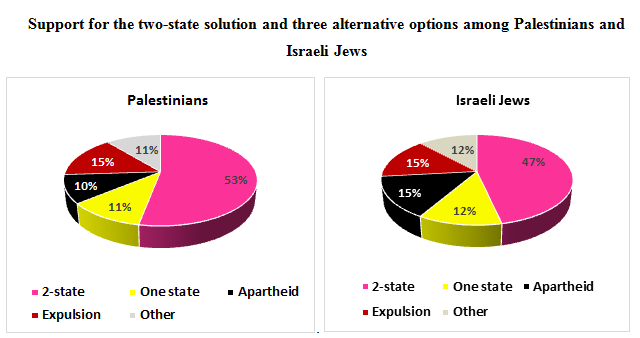
A closer examination of the split within the Palestinian side shows that aside from the support for the two-state solution, only minor differences exist between Gazans and West Bankers in their preferences for the three alternatives. But gaps do emerge when looking at the political affiliation or vote preferences. Yet even here, support among Hamas voters for the two-state solution emerges as the biggest followed by expulsion.
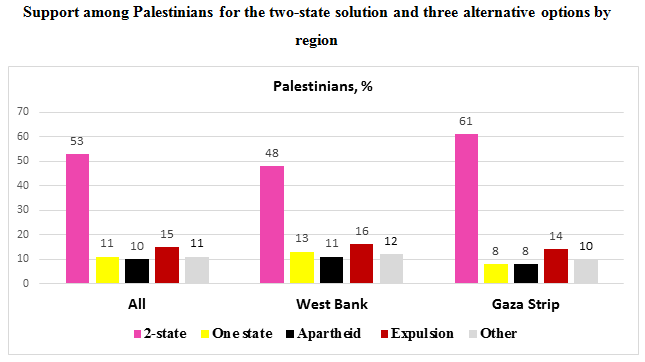
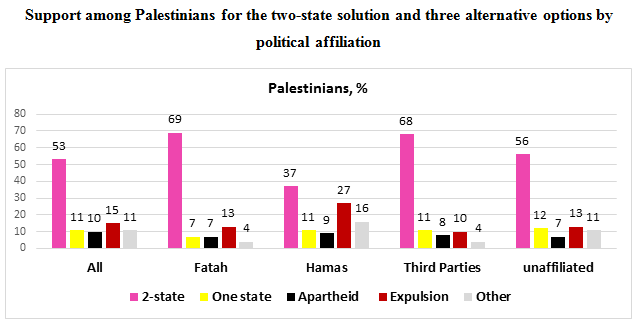
A similar examination of the Israeli Jewish side show that support for the two-state solution is highest only among secular and traditional Jews, but not among the religious (who prefer apartheid over all other) and the Ultra-Orthodox (who prefer expulsion over all other). But when looking at the political spectrum, support for the two-state solution is higher than all others among all except the right (who prefer apartheid).
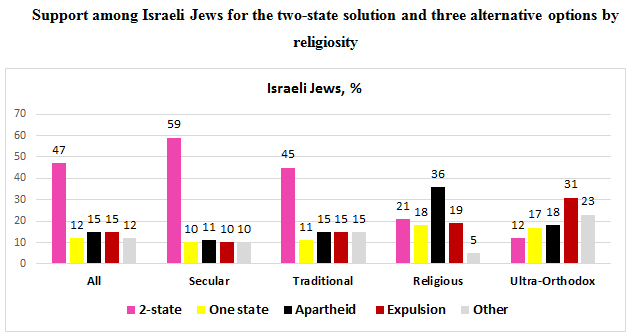
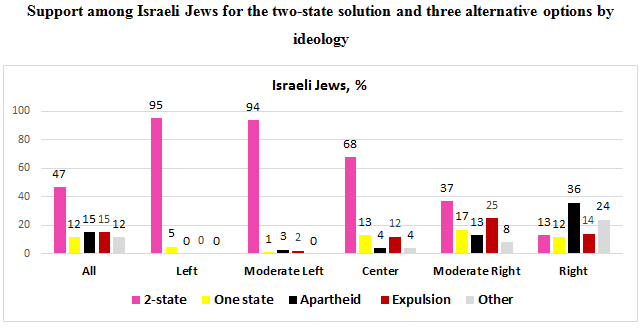
Finally, when looking at Israeli Arabs, as the pie below shows, support for the two-state solution, as indicated above, is overwhelming, followed by support for the one state solution. This means that, as in the case of Israeli Jews and Palestinians, once the overlap in the Israeli Arab sample is removed, little support remains for these two alternatives.

Confederation: For the second time, we tested an alternative to the traditional two-state solution in the form of a confederation between two states. In December 2016, the question was asked without a significant explanation of what this would mean. In the current survey we provided more detail about the idea, in the following form:
“Some people recommend the following solution: the creation of two states, Palestine and Israel, which enter into a confederation whereby citizens of one country are allowed to live as permanent residents in the territory of the other but each national group votes only in its state for elections. There would be freedom of movement for all, and Jerusalem is not divided but serves as the capital of two states. Israel and Palestine would deal jointly with security and the economy..
The new concept does not immediately appeal to Jews: 26% of Jewish Israelis said they would support the confederation of two states, a six point increase from six months ago, when the question did not provide the details above, but asked about support for the following:
“a confederation between the state of Israel and the state of Palestine whereby citizens of one country would be free to reside in the territory of the other and live under its own laws and where two the states jointly decide on matters of political, security and economic policy.”
Palestinian attitudes towards the more detailed confederation idea rose three points from December, to 37% support, but a majority, 58%, opposed. As is the case for all possible solutions, support for the confederation idea is highest among Israeli Arabs, at 61%, with 35% opposed.
Detailed package for implementation
Palestinians and Israelis were then asked to support or oppose a detailed combined package of a permanent settlement, gathered from previous rounds of Palestinian-Israeli negotiations. They responded first to each item separately, as component parts; following nine such items they were asked if they support or opposed the combined package, and given a short summary of the basic elements. Findings show that the level of support for the package reflects the change of opinion seen among each population regarding the general two-state solution: it has increased slightly among Palestinians, and decreased somewhat among Israelis. At present: 43% of the Palestinians support the full package (40% among West Bankers, who show no change from December – and half of Gazans. Among Gaza respondents, this represents a steady seven-point rise from June 2016 and December 2016; the current higher rate in Gaza accounts for the rise of the overall figure). Among all Israelis, 41% support this package: 32% among Israeli Jews and 83% among Israeli Arabs. Six months ago, 41% of Israeli Jews and 88% of Israeli Arabs supported the package.

In the current survey, 60% of Jews inside the Green Line and 80% of settlers oppose this package (61% for all Israeli Jews). 54% of Palestinians oppose the combined package, unchanged from six months earlier.
Items of an agreement. A detailed breakdown of attitudes regarding the nine components of the package follows (non-italicized questions were asked of Israeli Jews and if no other wording appears, also for Palestinians and Israeli Arabs. Italics refer to the questions worded separately for Palestinians; some of the Palestinian wordings were used for Israeli Arabs):
1) Mutual recognition of Palestine and Israel as the homelands of their respective peoples. The agreement will mark the end of conflict, the Palestinian state will fight terror against Israelis, and no further claims will be made by either side. 66% of Israeli Jews support this, including 45% of West Bank settlers.
Mutual recognition of Palestine and Israel as the homelands of their respective peoples. The agreement will mark the end of conflict, Israel will fight terror against Palestinians, and no further claims will be made by either side. Nearly half, 49%, of Palestinians support mutual recognition. In Gaza 56% support it, and 45% support it in the West Bank. Over three quarters of Israeli Arabs support mutual recognition, or 76%.
2) The independent Palestinian state which will be established in the West Bank and the Gaza Strip will be demilitarized (no heavy weaponry). Fewer than one quarter of Palestinians support this (23%), and three-quarters oppose the demilitarized state. Among Israeli Jews, 61% support this item, and half of Israeli Arabs.
3) A multinational force will be established and deployed in the Palestinian state to ensure the security and safety of both sides. Among Palestinians, 39% support this, but over half of Gazans: 52%, while one-third of West Bank respondents support the multinational force. Israeli Jews were evenly divided, with 47% for and 49% against this item; among Israeli Arabs, 63% supported it.
4) The Palestinian state will have full sovereignty over its air space, its land, and its water resources, but Israel will maintain two early warning stations in the West Bank for 15 years. One-third of Palestinians support this, and nearly twice as many Gazans as West Bank Palestinians (47%, compared to 25%, respectively). Just over one-third of Israeli Jews support this (35%) and 59% of Israeli Arabs.
5) The Palestinian state will be established in the entirety of West Bank and the Gaza strip, except for several blocs of settlement which will be annexed to Israel in a territorial exchange. Israel will evacuate all other settlements. 34% of Palestinians support this, with a similar pattern: half of Gazans (51%) and 26% of West Bank respondents). 37% of Israeli Jews support this, and 59% of Arabs.
6) The territories Palestinians will receive in exchange will be similar to the size of the settlement blocs that will be annexed to Israel. Just under one third of Palestinians support the territorial exchange, again twice as many Gazans as West Bank Palestinians). 37% of Israeli Jews support this, and 59% of Israeli Arabs, the same breakdown of support for the concept of a territorial exchange.
7) West Jerusalem will be the capital of Israel and East Jerusalem the capital of the Palestinian state. Just over one-fifth (22%) of Jews support this item, and only 8% among West Bank settlers.
East Jerusalem will be the capital of the Palestinian state and West Jerusalem the capital of the Israel. 29% of Palestinians support this, with very little distinction between West Bank and Gazan respondents. .Nearly two-thirds of Israeli Arabs support this (64%).
8) In the Old City of Jerusalem, the Jewish quarter and the Wailing Wall will come under Israeli sovereignty and the Muslim and Christian quarters and Temple Mount will come under Palestinian sovereignty. Just over one-quarter of Israeli Jews support the Old City arrangement, with 69% opposed.
In the Old City of Jerusalem, the Muslim and Christian quarters and al Haram al Sharif will come under Palestinian sovereignty and the Jewish quarter and the Wailing Wall will come under Israeli sovereignty. Here again, just over one-quarter of Palestinians support the division of the Old City, with only small differences between Gaza and the West Bank. The same portion of Palestinians are opposed as Jewish Israelis: 69%. Over half of Israeli Arabs support this (53%).
9) Palestinian refugees will have the right of return to their homeland whereby the Palestinian state will settle all refugees wishing to live in it. Israel will allow the return of about 100,000 Palestinians as part of a of family unification program. All other refugees will be compensated. A majority of Palestinians support this, 55%, and 40% are opposed. This item shows a very large difference between Gazans – nearly three-quarters (72%) support it – and West Bankers: just 47%. This item receives the lowest support from Israeli Jews out of all the items tested: 18%, fewer than one-fifth, support the arrangement on refugees, while 77% are opposed. Israeli Arabs show the opposite trend: 81% support it, with 18% opposed.
Perception of social support for package. On both sides, respondents also perceive their own societies support for the plan to be low. Palestinians are more likely to say that among other Palestinians the majority supports the plan – 39% believe this, compared to 43% of Palestinians who actually support it – a slight difference. Over half (51% ) of Palestinians believe the majority of Palestinians oppose it – close to the reality of 54%. Among Israeli Jews, however, a high portion accurately believe the majority rejects the agreement: 71%. Although 32% of Israeli Jews support the plan, fewer than half that number – 15% – believe that the majority supports it.
It is interesting to note that among Israeli Jews, a higher portion think Palestinians would accept the combined package, than those who think the majority of Jews support it: 35% say that the majority of Palestinians support the package. Similarly, 46% of Palestinians think the majority of Israelis support the package – higher than the portion who believe their own side has majority support. This could indicate that they believe the agreement to be advantageous to the other side – and could further explain the doubts for those who are opposed.
Regional and demographic trends. The higher support among Gaza residents for each item is consistent with their overall higher support for the full package. This trend has been consistent since June 2016. Moreover, it is worth pointing out that the findings show no difference in support between refugees and non-refugees (43% and 44% respectively). Support for the package drops to 37% among those between the ages of 18 and 22 years compared to all other age groups where support ranges between 43%-45%. Moreover, support for the package is higher among those who define themselves as “not religious” and “somewhat religious” (60% and 44%, respectively) compared to those who define themselves as religious (40%). Fatah voters and voters of third parties support the package with large majorities (58% and 57% respectively) compared to only 28% among Hamas voters.

Just 18% of Israeli settlers support the full package, but even fewer national religious Jews: only 7%, which is even lower than the Haredi level of support of 12%. The findings reflect a very consistent religious-secular divide, with nearly half (46%) of secular Jews who support the full package. Among Israeli Arabs, there is almost no variation based on levels of religious observance. A second demographic divide is found between younger and older Jews. One-quarter of the 18-34 year old Jews support the package, compared to 37% among those above 55. However, young secular Jews support it at the same rate as other seculars: 45%.
Among all Israelis, with Jews and Arabs combined, support varies most of all depending on where respondents place themselves on the right-left political continuum: Nearly 80% of those who consider themselves left-wing support the full package (78%), a slim majority of centrists (51%), and 22% of right-wingers.
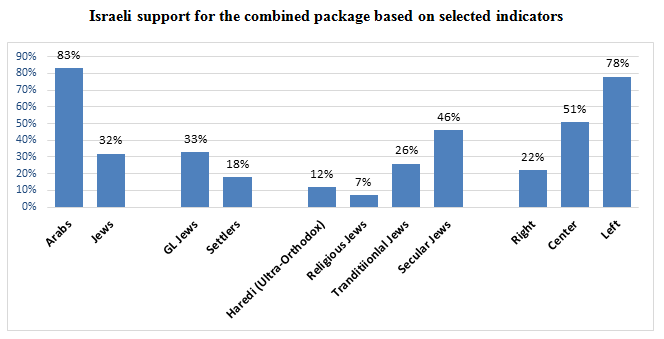
Feasibility – doubts. Beyond demographic and political differences that typically characterize those who support or oppose the two-state solution and the detailed package, background attitudes are also clearly linked to support. In the previous survey, it became clear that trust in the other side was a powerful factor, and the belief that the other side wants peace. It also became clear that the perception of viability was important, therefore in the current survey we offer deeper analysis of this factor.
Among Israeli Jews who believe that the two state solution is still viable, 53% support the combined package. Further, for Israeli Jews, support for the agreement rises in part on whether the respondents believe there is chance of establishing a Palestinian state within the next five years.
Feasibility – doubts. Beyond demographic and political differences that typically characterize those who support or oppose the two-state solution and the detailed package, background attitudes are also clearly linked to support. In the previous survey, it became clear that trust in the other side was a powerful factor, and the belief that the other side wants peace. It also became clear that the perception of viability was important, therefore in the current survey we offer deeper analysis of this factor.
Among Israeli Jews who believe that the two state solution is still viable, 53% support the combined package. Further, for Israeli Jews, support for the agreement rises in part on whether the respondents believe there is chance of establishing a Palestinian state within the next five years.
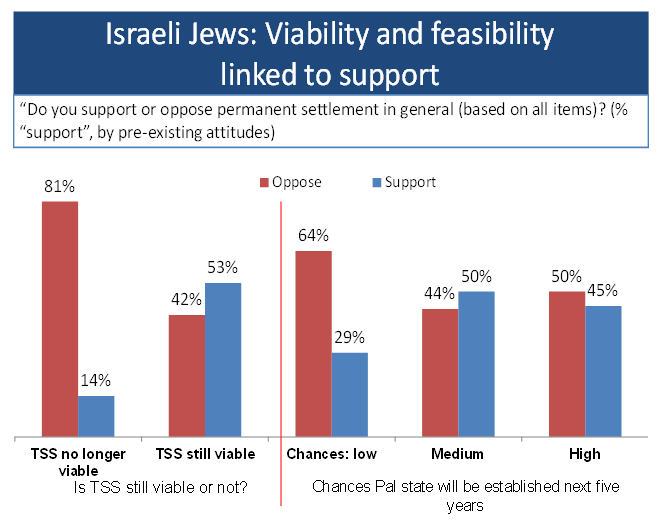
Among the Palestinians who believe that the two state solution is still viable, 64% support the combined package. Further, support for the agreement rises incrementally the more the respondents believe there is chance of establishing a Palestinian state within the next five years.

Peace Incentives: Changing minds
Our joint poll sought to explore the extent to which the opposition to the combined package was “firm” or “flexible,” that is, whether additional policy items can act as incentives to change their minds in favor. To this end, we developed a series of policies that could be added to an agreement, and proposed them to respondents who originally said they opposed the full, detailed package. As noted above, this included 61% of Israeli Jews, 15% of Israeli Arabs, and 54% of Palestinians.
Each side was offered seven incentives. Some of the incentives were similar, reflecting either the same policy or a parallel item. Three items tested the same policy: making the Israeli-Palestinian agreement part of the Arab Peace Initiative; including joint Palestinian-Israeli economic ventures; and both sides were asked about the other side removing incitement from their education textbooks, as an incentive. One item was a policy area specifically favorable to one side: for Israelis – allowing the Israeli air force access to Palestinian airspace, and for the Palestinians, release of all prisoners. A fifth incentive stated that the agreement would include a gesture by each side, of a particularly sensitive aspect of the other side’s experience: an apology for the suffering of Palestinian refugees, and the recognition of Jewish holy sites in “Judea and Samaria.” Finally, each side was told that the other side would recognize the national and religious character of its state.
The items were tested as follows (italics indicates questions asked of Palestinians). Once again these questions were asked only among those who opposed the full package of the detailed two state agreement.
1) And if the agreement is part of a larger peace agreement with all Arab states according to the Arab Peace Initiative? 27% of Israeli Jews who opposed the agreement at first, said that they would now support it. Added to those who already support the agreement (32%), nearly half of Israeli Jews would support it with this item.
If in addition to the above items of the permanent settlement package, Israel agreed to accept the Arab peace initiative and in return all Arab countries supported this peace treaty? Nearly one-quarter of Palestinians who did not support the initial package said they would support it if this case (24%).
2) And if the agreement allows for joint Israeli-Palestinian economic ventures? One-quarter of Israeli Jews (25%) said this would make them support the agreement.
And if the agreement allows for joint Palestinian-Israeli economic ventures? Over one-quarter (27%) of Palestinians said they would support the agreement with this item.
3) And what if the Palestinians agree to change school textbooks to remove incitement against Jews? Over one-third of Jewish Israelis who initially opposed the agreement said they would support if it this item was included.
And what if the Israelis agree to change school textbooks so that they not include incitement against Palestinians? Nearly one-third (32%) of Palestinians opposed would support the agreement if it included this item.
4) What if the agreement allows the Israeli air force full access to Palestinian airspace? 30% of Israeli Jews would support the agreement with this item.
And if the agreement mandates the release of all Palestinian prisoners? Among those opposed, fully 56% said they would change their minds and support an agreement if all prisoners were released. Combined with those who support the original agreement already, close to three-quarters of Palestinians in total (73%) could support the agreement if it includes this incentive.
5) And if the agreement recognizes Jewish holy sites in Judea and Samaria and specifies that Jews have full rights to visit those places with security guarantees? One-third of Jewish Israelis would support the agreement in this case.
And if Israel agrees to apologize for the suffering the conflict has inflicted on the Palestinian refugees? 32% of Palestinians said this would make them change their minds and support an agreement.
6) And if the agreement states that the Palestinians explicitly recognize Israel as a Jewish state, and recognize the Jewish historic and religious ties to the land of Israel? For this item, 43% of Israeli Jews said they would change their minds from opposing to supporting the agreement. When added to the original number of supporters of the original agreement, 58% of Israeli Jews in total would support the package if it includes this incentive.
And if the agreement entails Israeli recognition of the Arab and Islamic character of the Palestinian state? Almost the same portion of Palestinians as Israeli Jews, 42%, said they would change their minds and support the original agreement based on this addition, bringing total Palestinian support to nearly two-thirds (66%).
7) And if Prime Minister Netanyahu declared his support for the package? 29% of Israeli Jews said they would support the agreement in that case.
And if Marwan Barghouti declared his support for the package? 34% of Palestinians said they would support the package in that case.
Israeli Arabs were asked about the incentives according to the Palestinian versions. However the number who initially opposed the agreement was very low – just 24 respondents. The breakdowns therefore are not statistically significant; however it is worth noting the most successful initiatives: three-quarters said they would change their minds in the case of joint Palestinian-Israeli economic ventures, and two-thirds said they would support it if incitement against Palestinians in Israeli textbooks is changed. The results above are shown in the following graphs:
Willingness of Israeli Jews who opposed to the peace agreement package to change position and support the combined package based on various incentives


In all, between one-quarter to 43% of Jews who were opposed to an agreement said they would change their minds and support it based on one of these incentives. Among Palestinians, from one-quarter to 56% of those who rejected the agreement could change their minds. With added support, several of the incentives could convince enough respondents to reach a majority, or even a strong majority. This indicates significant flexibility and openness of attitudes; it also implies that rejection of the two state implementation package is not entirely ideological, but can be changed with the right policies. Mutual recognition is a powerful incentive for both parties – while for Palestinians, releasing the prisoners Israel currently holds is the most powerful.
2) Approaches to Conflict Resolution
Negotiation Framework and Third Parties: The previous survey from December showed that the large majority of both Israelis and Palestinians believe the current US administration to be pro-Israel rather than neutral/balanced, or pro-Palestinian – about two-thirds of Israelis and over three-quarters of Palestinians.
In this context, it is valuable to consider alternatives to the US-brokered negotiation processes that characterized the last two decades. In the last two surveys, we tested five models for a multi-lateral approach to negotiations: 1) an Arab forum in which Saudi Arabia, Egypt and Jordan participate; 2) an American-led peace process; 3) an EU-led peace process; 4) a UN-led peace process; 5) and finally, a US-Russian-led peace process. Findings show that in both surveys, Palestinians are most receptive to the first, or Arab regional, approach (31% in December and the current June 2017 survey) followed by a UN and an EU approaches (17% and 10% respectively at present); 7% selected a US-led multi-lateral process, and 5% choose an American-Russian led peace process.
Israeli Jews preferred a US-led peace process consistently in both surveys (32%), while 19% selected a US-Russian approach, and 17% selected a regional approach led by Arab states. A UN-led process was selected by just 5% of Israeli Jews in both surveys and support for an EU-led process is just 2% – this reflects ongoing perceptions in Israeli society that both bodies are biased against Israel, a theme regularly repeated in public discourse.
Among Israelis Arabs, the Arab-led regional approach had the highest support, with over one-quarter (26%) who selected this option. 18% chose an EU process and the same portion preferred a US-led process; 15% selected a UN led process and 9% chose the US-Russian approach.
When all Israeli respondents are considered together, an Arab-led regional process ranks second choice, with 19% who preferred this approach – which is the top preference of both Palestinians and Israeli Arabs.
3) How Israelis and Palestinians View Each Other
We asked the two sides about perceptions of both the other, and themselves: whether they want peace or believe the other side does, whether they trust and whether they fear the other side, and for the first time since
June 2016, what they believe are the goals of both their side and the other side. We probed the extent of zero sum beliefs. The picture is mostly consistent with trends in our recent surveys.
Does the other side want peace? Among Palestinians, 44% agree that most Israelis want peace, a rise from December 2016, when 38% of the Palestinians felt this way. One-third (33%) of Israeli Jews think most Palestinians want peace, a decline from December, when 41% of Jews agreed with the statement that “most Palestinians want peace.” Among Israeli Arabs 54% agree that most Palestinians want peace, and 52% agree that Israeli Jews want peace.
Aspirations of each side: The majority on both sides believe that the opposing side has maximalist and destructive aspirations in the conflict.
Nearly one-quarter (24%) of Israeli Jews believe the Palestinians’ main aspiration is to take over the entire state of Israel from pre-’48 borders, and nearly forty percent (38%) believe that Palestinians want to conquer Israel and destroy much of the Jewish population. In total, 62% of Israelis believe Palestinians hold one of these maximalist positions.
In the eyes of the Palestinians, these assessments are inaccurate; in fact the strong plurality of Palestinians, 42%, believe that the long-term aspiration of the PA/PLO is to regain some of the territory from 1967, and another 19% believes the goal is to regain all of the ’67 territories; thus 61% combined view the PA as seeking more moderate goals. Just 11% believe the PA/PLO holds the extreme aspiration of conquering all of Israel and destroying the Jewish population, and 13% cites conquering all of Israel – one-quarter in total.
Among Palestinians, 57% believe Israel wants to extend its borders from the river to the sea and expel the Palestinian population. Another 21% believes Israel wants to annex the West Bank but deny the Palestinians political rights. Together, 78% believe Israel holds a maximalist position. There are significant differences between Palestinians in the West Bank and in Gaza regarding perception of Israeli aspirations: 42% of Gazans believe that Israel seeks a more moderate goal to withdraw from all (21%) or part (21%) of the territories it occupied in 1967, but just 9% of West Bankers combined, for both goals. By contrast, 69% of West Bank respondents held one of the two most extreme view of Israeli goals: extending its borders and expelling the Palestinians – but just one-third of Gazans.
In the eyes of the Israelis, these perceptions are inaccurate. Just one-third of Israeli Jews believes that their state holds the maximalist goals of either annexing all of the West Bank and expelling the Palestinians (14%) or annexing it without giving rights to the Palestinians there (20%) – one third in total.
Trust/Zero-Sum Conflict: As in previous recent surveys, levels of trust in the other side are very low and distrust is overriding. Among Palestinians a solid majority feels Israeli Jews are untrustworthy (87% – unchanged from 86% in December 2016). Israeli Arabs are deeply divided on this: 50% disagree that Israeli Jews can be trusted, and 49% agree.
On the Israeli Jewish side, over three-quarters (77%) believe that Palestinians cannot be trusted, up from 71% in December, and just 18% agreed with the statement that they can be trusted.
Distrust is reinforced by a prevailing perception on both sides that the Palestinian-Israeli conflict is characterized by zero-sum relations: “Nothing can be done that’s good for both sides; whatever is good for one side is bad for the other side.” Findings show that 53% of Israeli Jews (compared to 51% in December), 44% of Israeli Arabs (four points higher than December), and 72% of Palestinians (also up four points) agree with this dismal zero-sum characterization.
Fear: More Palestinians fear Israeli soldiers and armed settlers more than they fear Israeli Jews. Half agreed with the statement “I feel fear towards Israeli soldiers and armed settlers,” but 40% agreed with the statement made about Jews. This trend is nearly unchanged from December. There are significant differences between West Bank and Gaza respondents: 57% from the West Bank fear soldiers and settlers, while just 36% of Gazans do – this could reflect the fact that West Bankers have more significant daily contact with such figures; although it is also consistent with milder attitudes among Gaza in general.
Among Israelis, a larger majority of two-thirds agree with the statement “I feel fear toward Palestinians,” unchanged from December 2016. Among settlers fully three-quarters agree. Regarding Arab-Jewish relations among Israeli citizens, nearly half of Jews agree that they fear Israeli Arabs, and one-quarter of Israeli Arabs agree with a statement that they fear Israeli Jews; 73% disagree.
General Conditions of the two sides: 55% of the Palestinians describe conditions in the Palestinian territories as bad or very bad; the portion of those in Gaza who feel life condition are bad has risen 10 points since December, to nearly three-quarters (72%). Among Israelis, settlers are the most satisfied population, with 64% who say the country’s condition is good or very good, relative to 54% among both Jews (and the total for Israelis) who say the conditions are good or very good. Half of Israeli Arabs said conditions are good; around 30% among all Israeli groups, and nearly one-quarter of Palestinians, say conditions are “so-so.”
(4) Values and Goals
Values and Goals: We asked Israelis and the Palestinians about the hierarchy of the values and goals they aspire to maintain or achieve. Jews were asked about the values of: (1) a Jewish majority, (2) Greater Israel, (3) Democracy, (4) Peace. Among Israeli Jews, a Jewish majority is seen as the most important value (31%), followed by democracy (19%). The portion who chose democracy rose between June and December 2016, and has now decreased back to the June 2016 level. However, the number who chose peace rose from December, from 23% to 29% in June – close to the level of one year ago (32% in June 2016). Although “Greater Israel” is ranked lowest of the four, the portion of those who select this as the highest priority has grown in a mild but steady trend from one year ago: from 10% in June 2016, to 14% in December and 17% in the current survey.
Among the Palestinians, we asked about the following goals: (1) Israeli withdrawal and establishing a Palestinian state, (2) Obtaining right of return for refugees to ’48 Israel, (3) Establishing a democratic political system, (4) Building a pious or moral individual and religious society. For Palestinians, the ranking has been stable, with almost no change over the course of the year. The top priority for Palestinian goals remains Israeli withdrawal to the 1967 borders and the establishment of a Palestinian state in the West Bank and the Gaza Strip with East Jerusalem (43% chose this), followed by obtaining the right of return to refugees to their 1948 towns and villages (29%), building a pious or moral individual and a religious society (16%) and building a democratic political system (13%).

